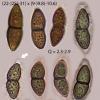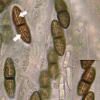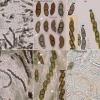
30-11-2025 12:53
 Edvin Johannesen
Edvin Johannesen
White short-stipitate apothecia found on thin twig

30-11-2025 10:47
 William Slosse
William Slosse
I recently found a collection of small Peziza sp.

27-11-2025 12:01
Thomas Læssøehttps://svampe.databasen.org/observations/10496727

27-11-2025 11:46
Thomas Læssøehttps://svampe.databasen.org/observations/10493918

17-09-2025 10:50
Heather MerryleesHi there!I am hoping for any advice on the identif

29-11-2025 08:40
 Andreas Millinger
Andreas Millinger
Hello,on a splintered part of a branch on the grou

28-11-2025 16:45
Nogueira HéctorNovember 23, 2025 Requejo de Sanabria (León) SPAI

25-11-2025 14:24
Thomas Læssøehttps://svampe.databasen.org/observations/10490522

27-11-2025 15:41
Thomas LæssøeSpores brownish, typically 4-celled; 26.8 x 2.4;

27-11-2025 11:31
Thomas LæssøeCollectors notes: Immersed ascomata, erumpent thro
The blackish, roundish, inmersed perithecia, single or in pairs, are more or less roundish, up to 1 mm in diam., beneath a thin clypeus. Only the papilla is visible on the peridermis of the host, but it is not surrounded by teeth-like flanges as described for Seynesia nobilis.
The 8-spored asci have a wedge-shaped, amyloid, subapical apparatus. The living paraphyses are filled with a conspicuous, refractive, oily content that not dissapear in NH4OH. The ascospores are brownish at maturity, smooth-walled, two celled, constricted at the septum, with a full length germ slit in each cell, a thin mucilaginous sheath surrounding the ascospores and an obtuse or short cylindrical, not really conical, cap-like appendage at each pole of the spore.
I feel this species could be into the genus Seynesia, but I think it doesn't fit well with the somewhat known species of this genus (i.e. S. nobilis)
What is your opnion
Many thanks in advance

I was sure Arundo would give you nice suprises!
It's obviously a Seynesia and I find it fits fairly well in S. nobilis. Do you have Hyde's paper (1995) in Sydowia? He states that the teeth-like flanges around the clypeus are not always present, likely dependent on the texture of the host. Only the paraphyses with refractive content do not match.
I never encountered S. nobilis, thus I cannot discuss any more.
Saludos,
Jacques
Hi Jacques
Many thanks for your help and for advising me the study of Arundo



